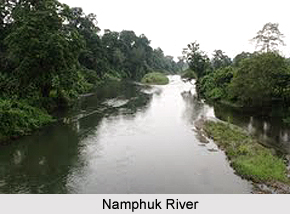 Geography of Dibrugarh District is spread over extensive plain formed by the Brahmaputra River and its major tributary is Buri Dihing. Dibrugarh District is situated in the northeastern corner of the upper Brahmaputra valley south with an elevation ranging between 99 to 474 meters.
Geography of Dibrugarh District is spread over extensive plain formed by the Brahmaputra River and its major tributary is Buri Dihing. Dibrugarh District is situated in the northeastern corner of the upper Brahmaputra valley south with an elevation ranging between 99 to 474 meters.
The geography of Dibrugarh District is constituted by a variety of elements such as flood plain, beels and swamps, occasional highlands and foothills. Brahmaputra River is wide in this region. The general inclination of the district is from southeast to north-west. The altitude of the southeastern corner covering the Hapjan Parvat and Hilika Parvat of the Barail foot hills is around 200 metres. The northern belt of the area has a gentle slope from east to west. The altitude of the eastern part is 115 metres, while it is 99 metres in the western part. Because of moderately high slope and large volume of water, river Brahmaputra flows with a high velocity causing significant bank erosion in the area.
Geography of Dibrugarh District is divided into three distinct zones stretching parallel to the Brahmaputra River. These are the active floodplain and `charland`, the middle plain; and the southern foothills. The first zone is an extensive and active floodplain of river Brahmaputra. The second zone is extensive because of the presence of fairly large tributaries like the Dibru (which has now merged with the Brahmaputra) and the Buri Dihing through their head ward corrosion added alluvial land substantially to the great plain of the Brahmaputra River. This plain contains the rich belts of tea and rice cultivation. The foothill zone on the other hand consists of isolated hillocks interspersed with plain embayment extending into the Naga Hills. Tea gardens or dense forests mostly cover the high grounds of this zone.
On the northern margin of the Dibrugarh District lies river Brahmaputra which basically drains the whole area. Near the Dibrugarh city the river is 10 kms wide with a large number of sandbars. Buri Dihing River flows from almost east to west through the area. It has many tributaries such as Digboi, Tingrai, Tipling, Telpani, Deherang and Sessa in the north bank and Tipam and Disam in the south bank. In addition to the tributaries of the Burhi Dihing, there are three other tributaries of the Disang River (in Sibsagar) namely Gela Disam, Tiolo and Demow. Official reports suggest that Burhi Dhing is the erstwhile Namphuk River.
Like any other parts of Assam, this region is endowed with extensive water resources. Dibrugarh District possesses a large number of wetlands of varying sizes. The larger ones are popularly know as beel, while the marshes and swamps are generally known as jalah, doloni, pitoni, doba, etc. All these features constitute the wetland. The wetlands may broadly be divided into two categories - the lake-like ones and the swamps and marshes covered by weeds, grasses, etc. Both the beels and the swamps are geo-morphologically, ecologically and economically very important features. These comprise a major component of the area`s ecology. The beels are traditionally used as natural fisheries. Even today, the beels produce more fish per unit area than any many other man-made fisheries. A large number of beels are connected with the rivers by one or more feeder channels.
The soils of Dibrugarh District are basically the products of the fluvial processes of the Brahmaputra River and its tributaries. It includes plains that are composed of alluvium that are classified as new and old. The new alluvium varies mostly from clayey to sandy loam in texture and is slightly acidic in reaction. It is found in the vast plain of Dibrugarh District along the river valleys, especially in their lower courses. The old alluvium on the other hand occurs in the upper and middle parts of the valleys. The riverbanks of the region bear texturally three types of soil - sandy loam, loam and clayey loam. These favour the cultivation of rice, mustard, pea, vegetables, etc. Thus, geographically the soils of Dibrugarh District are considered as favourable for cultivation and plantation.






